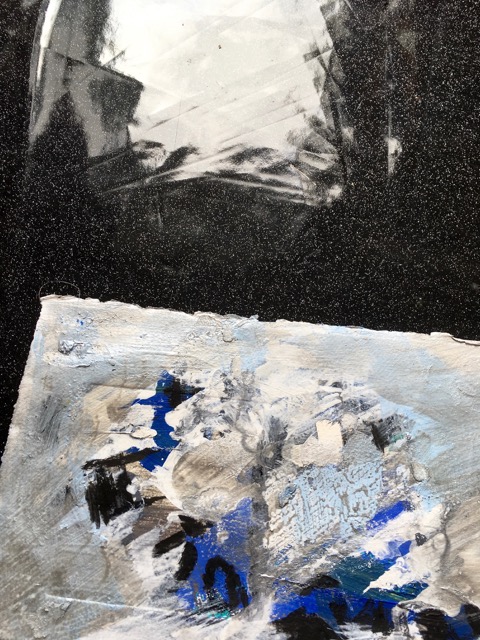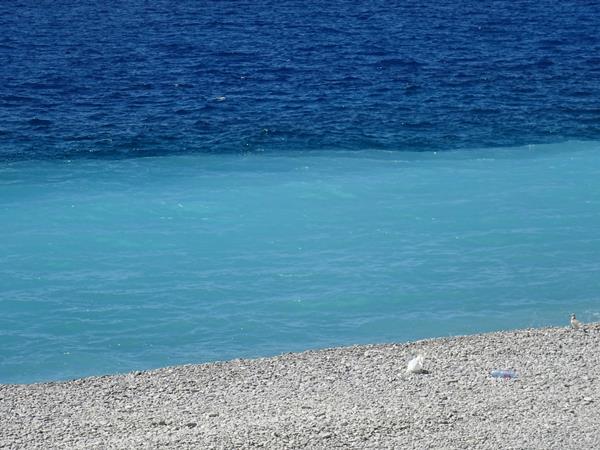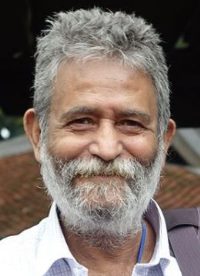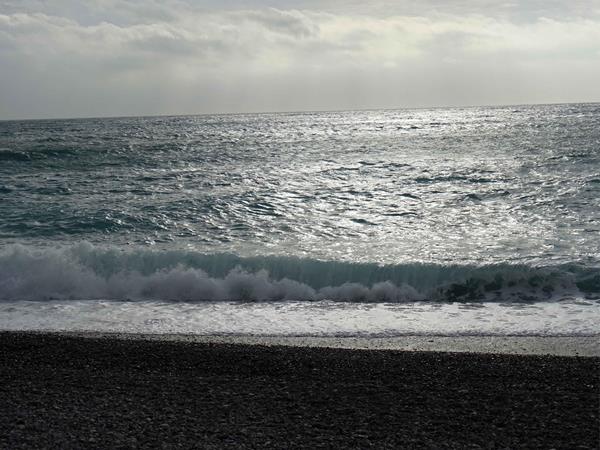Silence (29) - Tĩnh lặng (29). Mai Văn Phấn. Explicated by Dr. Ramesh Chandra Mukhopadhyaya - chú giải. Traduction française Dominique de Miscault – Dịch sang tiếng Pháp. Takya Đỗ dịch sang tiếng Việt
Silence (29) by Mai Văn Phấn
Explicated by Dr. Ramesh Chandra Mukhopadhyaya
Translated into French by Dominique de Miscault
Translated into Vietnamese by Takya Đỗ

Tranh của HS. Dominique de Miscault
Silence
29
On
the way to shore
Lies
a sand plot
Oyster
shells
Bow
in the lapping waves
Shapes
of seagulls flying
Or
just landing on the horizon
Are
like contours
Of a
person lying face down
Wind
blowing from the sea
Sticks
me to my shirt
Then
inflates the fabric
My
body inside
Is
the core
The
bitter seed
Of a half ripe fruit.
(Translated from Vietnamese by Nhat-Lang Le & Susan Blanshard)
Explication
A
beautiful poem that dwells on the poet’s visit to a sea side, While approaching
the sea shore the poet finds a sand plot. Water lapping there may have drawn
the eyes and the ears of the poet. Oyster shells bow in the waters. In other
words the hollow in the oyster shells are facing the earth. At the same time
the sea gulls flying or landing on horizon are like contours of a person
lying face down. Thus, small oyster shells at the edge of the plot of sand are
in the foreground. And the background has the horizon where the earth and
the skies meet and there the seagulls liken a human being prostrating. This is
a unique description of the sea where the oyster shells near and the shapes of
seagulls there together prostrate like a person. Whom do they bow down before?
Surely it is the infinitude apparent in the waves that are limited
by the horizon below the boundless azure dome. In other words the whole
creation is a prayer hall where the living as well as the inert are lying with
the face down. But the man in the poet does not participate in this prayer. The
wind from the seas enters into the shirt of the poet and he looks inflated. His
body lurks below the wind blown shirt. The body is thus like the seed hidden in
an inflated fruit. Through the observation of the self that speaks of an
appearance in apparels blown up and the seed of the body
contracted in relation to the blown up shirt might suggest that the
appearance never gives one the truth. At the same time the appearance of the
seagulls or the oysters might not be true. And it is a pity that we can
perceive the other only with the aid of our senses. So we can see the shapes of
the seagulls forging together another shape----the shape of a man reclining
facing the earth. Even when we look into ourselves we see the shirt. Below that
apparent body there is another body which is not inflated by the sea wind But
that body below the shirt is not the self. It is a half ripe seed. If a
seed is not ripe it is of no avail. The word seed is very significant. The body
that wears the shirt has also in it the seed of consciousness which implies the
storehouse of consciousness and accumulated karma that helps to form the consciousness.
This seed of consciousness and karma goads one from one life to another.
But there is seed within seed. The Buddha mind lurks below every level of
appearance. But when the poet describes his body as the seed he
might speak of himself as an unmanifest inarticulate sound still in the process
of becoming. When he becomes ripe or mature in consciousness he can give us the
seed sound that might unveil the mystery of creation. The poet thus calling
himself a half ripe seed unwittingly betrays the fact that he is a bodhisattva.
Our salutes to him.The shirt stands for the petals that protect a seed. The
half ripe seed or the poet in the making whose words will charge the world with
love and compassion has come to have a glimpse of the sea and the sky where all
life and the remains of living beings prostrate before the Buddha mind.
Explication par Dr. Ramesh Chandra Mukhopadhyaya
Traduction française Dominique de Miscault

Photo: Dominique de Miscault
Silence
29
Sur le rivage
de sable
des coquilles d'huîtres
ressacs
Ombres des mouettes en vol
touchent l'horizon
contours
d'un corps allongé sur le ventre
Le vent souffle de la mer
colle à ma chemise
gonfle ma chemise
Mon corps intérieur
noyau
graine amère
fruit à moitié-mûr.
Explication
Un beau poème de bord de mer où le poète est debout sur le sable. La vue et
le vacarme des ressacs le fascinent. Des coquilles d’huîtres sont couchées dans
les eaux, l’intérieur face contre terre. Tandis que, les mouettes en ombres
chinoises, à l'horizon simulent des hommes allongés face contre terre. Ainsi,
sur le sable, au premier plan, de petites coquilles d'huîtres et à l'horizon où
se fondent la terre et le ciel, des mouettes s’inclinent. Image étonnante où
les coquilles d'huître ici et des mouettes là-bas s’inclinent comme des êtres
humains. Devant qui se prosternent-elles ? Certes, c'est la répétition
apparente des vagues limitées à l'horizon sous le dôme infini de l’azur. En
d'autres termes, toute la création est en prière : les vivants comme les
objets adorent leur créateur. Mais l'homme dans le poète ne participe pas à
cette prière. Le vent de la mer gonfle sa chemise, son corps caché par sa
chemise gonflée de vent. Le corps est donc comme une graine cachée dans un
fruit gonflé. Cette observation du soi qui parle de l’apparence des vêtements
et de la semence dans le corps contractée par rapport à la chemise gonflée,
pourrait suggérer que l'apparence n’est jamais la vérité. De même les images
des mouettes ou des huîtres pourraient ne pas être vraies non plus ... Quel
dommage que nous ne puissions percevoir l'autre qu'avec nos sens. Sinon, nous
pourrions voir les ombres des mouettes d’une toute autre manière – que celle
d’un homme au loin, les bras en croix, le visage contre terre. Lorsque nous
nous regardons, nous-même, nous nous voyons en chemise. Au-dessous de ce corps
apparent, il y a un autre corps, qui n'est pas gonflé par le vent de mer.
Cependant, ce corps sous la chemise n'est pas moi. C'est une graine à moitié
mûre. Si une graine n'est pas mûre, elle est inutile. Le mot graine est très
important. Le corps qui porte la chemise contient aussi une semence de
conscience, ce qui implique un lieu de conscience ou karma accumulé. Cette semence de conscience et de karma se stimulent
d'une vie à l'autre. Mais il y a de la semence au sein de la semence. L'esprit
de Bouddha se cache dessous chaque niveau d'apparence. Quand le poète décrit
son corps comme une graine, il pourrait aussi parler de lui-même comme une fête
inarticulée dans un processus en devenir. Une fois sa conscience murie, il
pourrait nous donner le son de la semence et ainsi dévoiler le mystère de la
création. Le poète qui se dit lui-même une graine à moitié mûre trahit
involontairement le fait qu'il est bodhisattva. Saluons-le. La chemise
représente les pétales qui protègent la graine. La semence à moitié mûre ou le
poète en devenir dont les paroles chargent le monde d'amour et de compassion
ont été perçues de la mer et du ciel où toutes vies et les hommes se
prosternent devant Bouddha.
Tĩnh lặng (29) của Mai Văn Phấn
Ramesh Chandra Mukhopadhyaya chú giải
Takya Đỗ dịch sang tiếng Việt
29
Lối lên bờ
Doi cát
Những vỏ sò
Cúi đầu trong sóng vỗ
Dáng hải âu bay
Hay vừa đậu
Tựa chân trời gợn tấm lưng
Người nằm sấp
Gió biển thổi
Dính tôi vào vạt áo
Rồi căng phồng
Cơ thể tôi ở giữa
Là chiếc lõi
Hạt đắng
Của một trái ương.
Chú giải:
...

Ts. Ramesh Chandra Mukhopadhyaya
Dr. Ramesh Chandra Mukhopadhyaya
Address: 6/ 1 Amrita Lal Nath lane P.0. Belur Math Dist Howrah West Bengal India Pin code711202. Date of Birth 11 02 1947. Education M.A [ triple] M Phil Ph D Sutrapitaka tirtha plus degree in homeopathy. He remains a retired teacher of B.B. College, Asansol, India. He has published books in different academic fields including religion, sociology, literature, economics, politics and so on. Most of his books have been written in vernacular i.e. Bengali. Was awarded gold medal by the University of Calcutta for studies in modern Bengali drama.
TS. Ramesh Chandra Mukhopadhyaya
Địa chỉ: 6/ 1 đường Amrita Lal Nath hòm thư Belur Math Dist Howrah Tây Bengal Ấn Độ mã số 711202. Ngày sinh: 11 02 1947. Thạc sĩ văn chương, thạc sĩ triết học, tiến sĩ triết học [bộ ba] cùng với Bằng y học về phép chữa vi lượng đồng cân. Ông còn là một giảng viên đã nghỉ hưu của Trường đại học B.B, Asansol, Ấn Độ. Ông đã có những cuốn sách được xuất bản về nhiều lĩnh vực học thuật bao gồm tôn giáo, xã hội học, văn học, kinh tế, chính trị v.v. Hầu hết sách của ông đã được viết bằng tiếng bản địa là tiếng Bengal. Ông đã được tặng thưởng huy chương vàng của Trường đại học Calcutta về các nghiên cứu nghệ thuật sân khấu Bengal hiện đại.

Nhà thơ - Nghệ sỹ Dominique de Miscault
Poétesse - Artiste Dominique de Miscault
Artiste Plasticienne. Actualités. De plages en pages qui se tournent. C’était hier, de 1967 à 1980, mais aussi avant hier. puis de 1981 à 1992. Et encore de 1992 à 2012 bien au delà des frontières. Aujourd’hui, la plage est blanche sous le bleu du soleil. Ecrire en images, cacher les mots porteurs de souffrance ; on ne raconte pas les pas d’une vie qui commence en 1947. C’est en 1969 que j’ai été invitée à exposer pour la première fois. Depuis j’ai eu l’occasion de « vagabonder » seule ou en groupe en France et dans le monde sûrement près de 300 fois. Les matériaux légers sont mes supports, ceux du voyage et de l’oubli.
www.dominiquedemiscault.fr
www.dominiquedemiscault.com
www.aleksander-lobanov.com
Nhà thơ - Nghệ sỹ Dominique de Miscault
Nghệ sĩ nghệ thuật thị giác đương đại. Từ bãi biển đến trang giấy. Là ngày hôm qua, từ 1967 đến 1980, và trước đó, rồi từ 1981 đến 1992. Và nữa từ 1992 đến 2012 trên tất cả các biên giới. Ngày hôm nay là bãi biển trắng dưới bầu trời xanh. Viết bằng hình ảnh, giấu từ ngữ mang nỗi đau, người ta không kể lại những bước đi trong cuộc đời tính từ năm 1947. Vào năm 1969, lần đầu tiên tôi được mời triển lãm tác phẩm. Kể từ đó, tôi có cơ hội một mình "lang bạt" hoặc theo nhóm ở nước Pháp và khắp nơi trên thế giới, chắc chắn gần 300 lần. Những chất liệu nhẹ là nguồn hỗ trợ tôi, những chất liệu của hành trình và quên lãng.
www.dominiquedemiscault.fr
www.dominiquedemiscault.com
www.aleksander-lobanov.com
Tĩnh lặng - Silence (1)
Tĩnh lặng - Silence (2)
Tĩnh lặng - Silence (3)
Tĩnh lặng - Silence (4)
Tĩnh lặng - Silence (5)
Tĩnh lặng - Silence (6)
Tĩnh lặng - Silence (7)
Tĩnh lặng - Silence (8)
Tĩnh lặng - Silence (9)
Tĩnh lặng - Silence (10)
Tĩnh lặng - Silence (11)
Tĩnh lặng - Silence (12)
Tĩnh lặng - Silence (13)
Tĩnh lặng - Silence (14)
Tĩnh lặng - Silence (15)
Tĩnh lặng - Silence (16)
Tĩnh lặng - Silence (17)
Tĩnh lặng - Silence (18)
Tĩnh lặng - Silence (19)
Tĩnh lặng - Silence (20)
Tĩnh lặng - Silence (21)
Tĩnh lặng - Silence (22)
Tĩnh lặng - Silence (23)
Tĩnh lặng - Silence (24)
Tĩnh lặng - Silence (25)
Tĩnh lặng - Silence (26)
Tĩnh lặng - Silence (27)
Tĩnh lặng - Silence (28)

Photo: Dominique de Miscault